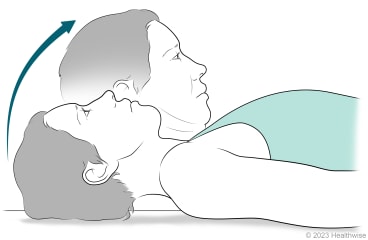Overview
Here are some examples of exercises for you to try. The exercises may be suggested for a condition or for rehabilitation. Start each exercise slowly. Ease off the exercises if you start to have pain. If you need to swallow for an exercise, use saliva, not food or drinks.
You will be told when you can start these exercises and which ones will work best for you. Only do the exercises that your doctor or speech therapist tells you to do. Follow their instructions carefully.
The exercises will help train your muscles and nerves to swallow so your food doesn't get stuck in your throat or go down the wrong way. They can also help you speak better. Your doctor or speech therapist will tell you how often to do the exercises and how many times you should repeat each one.
Shaker exercise

There are two ways to do this exercise. Your doctor or speech therapist may have you do it one or both ways.
- Lie on your back on a firm surface.
- Keep your shoulders flat. Don't lift your shoulders.
- Bend your head forward so that your chin tucks. Try to see your toes.
- Hold the position as your doctor or speech therapist tells you to. You can either:
- Hold this position for 1 minute, and then lower your head and rest for 1 minute.
- Or hold this position for 1 minute, and then lower your head and go on to the next repetition.
- Repeat these steps as many times as directed.
Supraglottic exercise
- Sit or stand comfortably.
- Take a deep breath and hold it.
- Swallow while holding your breath.
- Cough gently.
- Repeat these steps as many times as directed.
Super supraglottic exercise
- Sit or stand comfortably.
- Take a deep breath, and hold it while "bearing down" (like having a bowel movement).
- Swallow while you hold your breath.
- Cough gently.
- Repeat these steps as many times as directed.
Effortful swallow exercise
- Sit or stand comfortably.
- Squeeze your throat muscles as hard as you can, and then swallow. Imagine that you have a grape-sized piece of food stuck at the back of your throat, and try to swallow it.
- Repeat these steps as many times as directed.
Follow-up care is a key part of your treatment and safety. Be sure to make and go to all appointments, and contact your doctor if you are having problems. It's also a good idea to know your test results and keep a list of the medicines you take.
Current as of: October 25, 2024
Author: Ignite Healthwise, LLC Staff
Clinical Review Board
All Ignite Healthwise, LLC education is reviewed by a team that includes physicians, nurses, advanced practitioners, registered dieticians, and other healthcare professionals.

